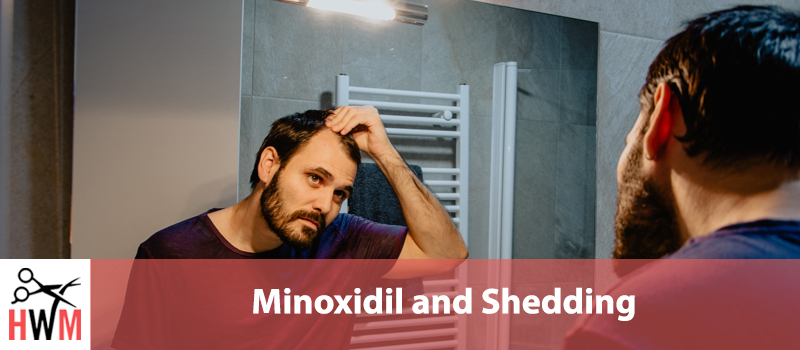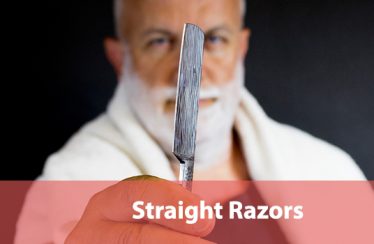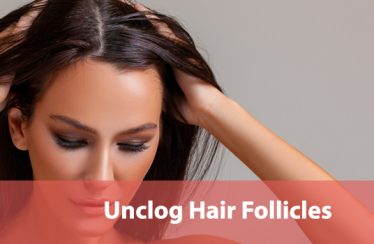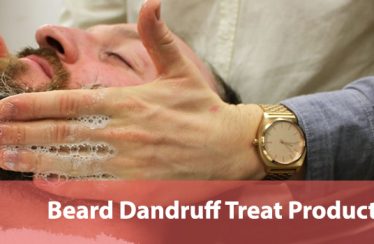Many men will experience hair loss or a receding hairline at one point in their life or another. Minoxidil is one of the best hair loss treatments you can be prescribed by your doctor. While it is quite effective at improving hair growth and thickness, it comes with several side effects.
The most obvious and alarming of these is a temporary increase in hair shedding. This can cause panic in some minoxidil users, but it’s actually nothing to be worried about. Of course, check wth your doctor, but it’s often a sign that things are going well.
Let’s go over minoxidil and why it causes shedding. We’ll also explain what you can do to make the most of the temporary experience.
- What is Minoxidil?
- How Does It Help?
- How to Use Minoxidil
- Shedding
- Why Does it Happen?
- Shedding Timeline
- Can You Stop the Shedding?
What is Minoxidil?
Minoxidil is a hair loss medication that can only be acquired from an over-the-counter prescription. It’s used for both men and women, although men are more frequent users of the drug since they suffer from hair loss more often.
Minoxidil comes in two forms: Rogaine and Theroxidil. There are some generic forms available, but these are the primary versions. All variants of Minoxidil come in either liquid or foam forms. Minoxidil can be sold in two strength variations as well: 2% or 5%. Generally, those seeking greater effects from the prescription receive the 5% version.
As a treatment, minoxidil helps relieve male pattern baldness and spot baldness in females. It’s not used to stall a mature hairline from developing or to fix a receding hairline. Instead, it’s applied at targeted locations and used to stimulate hair growth in certain portions of the scout.
Because it can be quite intense on the scalp, only men 18 years or older can acquire a prescription for the treatment. It’s also most effective on men under four years old. This is thought to be because the symptoms of male pattern baldness grow more intense as men age, outstripping minoxidil’s ability to help.
How Does It Help?
The exact mechanics from which minoxidil boosts hair growth are not known. But it’s important to know that minoxidil does not alleviate the causes of male pattern baldness. For instance, it doesn’t make your body less sensitive to DHT or lower the amount of DHT that your body produces.
Since DHT sensitivity or overproduction of DHT are the two primary causes of male pattern baldness, minoxidil is technically not a cure for the condition.
Instead, minoxidil boosts hair growth in an effort to outrace the effects of DHT. This makes it appropriate for men experiencing male pattern baldness for a variety of reasons.
Minoxidil also does not show results immediately. Most users of the prescription must maintain the application for four months regularly in order to see real benefits. In addition, the medication must be used continually to maintain hair growth rates and thickness. Skipping some days or failing to use medication properly may result in little or no results.
Common Hair Loss Causes
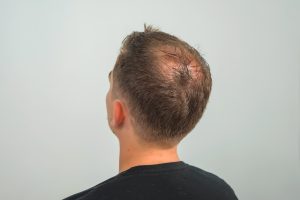
Most men suffer from male pattern baldness and hair loss thanks to DHT sensitivity or overproduction of DHT. DHT, also known as dihydrotestosterone, is a male androgen hormone that is responsible for many of the puberty changes males experience to make the masculine.
But it can also lead to hair loss and receding hairlines if your body makes too much of the hormone or your body is too sensitive to its effects.
You may also be suffering from hair loss from simple genetic misfortune, or your scalp might not be very healthy. In this case, your hair follicles don’t have the tools they need to produce hair as regularly as they should. Improper nutrition, similarly, can cause hair loss or stunted hair growth.
Minoxidil can assist with all of these hair loss scenarios.
How to Use Minoxidil
The exact application instructions for your variant of minoxidil might be different from the following instructions. Speak with your doctor and read the instructions carefully before using the drug to ensure that it is applied correctly.
However, most minoxidil drug variants follow the same general procedure.
First, you must clean and dry your scalp thoroughly. This involves using a cleansing shampoo and scrubbing away any dirt or debris that may have built up on your scalp over the previous day. When drying your hair, you can either totally dry the strands or leave them slightly damp.
After this, take the applicator or dropper that your minoxidil prescription should have come with and fill it with about 1 mL of the medication. About 20 drops are equivalent to 1 mL if your applicator doesn’t have clear markings.
Apply the solution to the areas of your scalp that are experiencing hair loss or thinning. You should rub the solution into your scalp with your fingers or the applicator itself. You must let the solution drive by itself on your scalp before allowing other cloth or styling products to touch the same area. Since this can take about 20 minutes, it’s recommended that you do this with plenty of time before bed to avoid rubbing the minoxidil into your pillow.
If you have a foam version of the solution, wash and dry your scalp as before. In addition, wash and dry your hands with cold water and make sure that they are mostly free from remnant moisture. Your foam minoxidil applicator should have come with a measuring cap.
Fill the cap about halfway with the foam. Then take this foam and rub it into the areas of your scalp where you are experiencing hair loss. As with the liquid version of minoxidil, you must let this foam drive by itself before going to bed or using other hair styling products.
Minoxidil is not meant to be used on any other part of the body. Applying the solution to other areas of skin can lead to inflammation or irritation.
In addition, minoxidil should only be used for the amount of time as indicated on the back of the prescription container. Some versions of minoxidil can be used multiple times per week while others will have a lighter application frequency. Whatever you were prescribed, don’t go above this limit. Your scalp will likely experience side effects regardless of how careful you are. It does no good to overtax your scalp.
Side Effects
Minoxidil use can lead to some side effects, although the exact intensity or symptoms can vary from person to person. Most frequently, minoxidil users experience some itching and dryness on their scalp regardless of prescription intensity.
Redness or flaking of the scalp is also common. Because the scalp dries out abnormally, dead skin flakes that pile up more frequently than usual. This could lead to follicle clogging if you are not careful and don’t thoroughly clean your scalp each night while taking the drug.
The 2% variant of minoxidil is slightly less intense than the 5% solution. This can be an effective choice if you already have a more sensitive scalp than average.
Minoxidil can also cause a more serious side effect: shedding.
Shedding
When men and women use minoxidil to improve their hair growth rate and thickness, they may experience significant hair shedding as a side effect. While this might sound like cause for alarm, it’s actually a normal process as the minoxidil starts to alter the way that your scalp produces hair.
Remember, minoxidil does not directly treat the cause of hair loss or male pattern baldness. Instead, it acts as a catalyst to improve hair growth and inspire your hair follicles to start producing new strands.
When minoxidil use leads to hair shedding, it’s merely a side effect of your scalp follicles changing their stage of hair growth in preparation to produce new hair.
Hair follicles work in three stages: the anagen phase, the catagen phase, and the telogen phase. Some think that minoxidil causes your hair follicles to skip the telogen phase prematurely in order to effect a reset of the current hair production schedule.
By resetting your hair follicles, minoxidil causes them to restart their hair production process and can speed up the rate at which you grow new hair. In effect, shedding is actually a sign that minoxidil is working as intended.
Why Does it Happen?
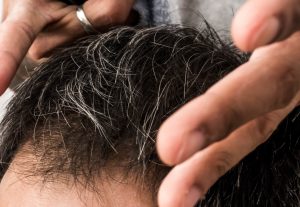
Minoxidil forces your hair follicles to skip over the telogen phase and move straight into the growth phase where they produce new hair strands. It causes a rush of blood and nutrients to the follicles, which can often cause those follicles to release the weaker hair that they currently have occupying their bulbs.
These weaker hairs can all fall out at once or in rapid succession. This can be alarming for users of minoxidil, but it’s usually just a prelude to stronger hairs taking their place.
Anagen Phase
This is the phase that minoxidil switches your follicles into regardless of their natural placement in the process. This is the primary growth phase for new hair strands and it usually lasts for 2 to 7 years. Skipping over the restful telogen stage allows your hair follicles to begin producing new hair now as opposed to many years from now.
Catagen Phase
This phase is what naturally comes after the anagen phase. It’s a transitory period that prepares the hair follicles for the restful telogen phase.
Telogen Phase
This is what minoxidil kicks your hair follicles out of. The telogen phase also naturally relaxes the follicles to allow your hair to be more easily pulled out or fallout from daily wear and tear. This is a healthy part of the process and it’s only alarming because minoxidil can cause it to happen to lots of hair follicles at once.
Normally, hair follicles all operate on their own schedules. Normally, you lose about 50 to 100 hairs per day. But you don’t notice it because each follicle in the telogen phase is far apart from the others.
Shedding Timeline
New users of minoxidil should experience the worst parts of the shedding side effect within 2 to 3 weeks from starting the treatment. After about a month of consistent minoxidil use, shedding should slow down and eventually ceased entirely.
In addition, some men and women don’t experience any shedding. But this is, paradoxically, a sign that minoxidil may not be working as intended.
In fact, men who experience severe shedding upon their first applications of minoxidil can take this as a good sign overall. It means that most of your follicles are receiving the treatment. You can expect better hair regrowth so long as you continue to use minoxidil consistently.
However, if your minoxidil-induced shedding continues for more than four weeks, you should contact your doctor and see if there is a separate medical condition causing the shedding. Your scalp may also be having a particularly bad reaction to minoxidil. In this case, you may need to search for a different hair growth treatment since minoxidil is causing too much shedding to take place.
Can You Stop the Shedding?
Shedding while using minoxidil is a normal part of the process. But that doesn’t mean that we have to like it. Some men and women don’t relish the idea of having to endure a bald head while they wait for hair to regrow.
However, stopping the shedding would be counter intuitive. Your follicles can only hold one hair strand at a time each. If you want to grow newer, stronger hair, the old and weak hairs must be discarded as soon as possible. This means that you’ll have to shed those old hairs one way or another.
But you can make the shedding process less intense or shorten the amount of time that you have to endure serious bald spots. These shedding alleviation methods are focused on improving your hair growth rate even further.
How to Shorten the Shedding Period
The key to shortening the shedding period when taking minoxidil is in promoting greater scalp health. For new and strong hair to grow more quickly, you must provide an optimal environment in terms of both cleanliness and nutrition. There are multiple ways through which you can achieve this end.
Essential Oils

One of the best homemade scalp health remedies is to make your own essential oil blend. Essential oils have been used by cultures all around the world for thousands of years to promote head health and improve scalp moisturization.
Essential oils are concentrated serums extracted from various parts of plants. These oils are highly irritating or dangerous when rubbed onto the skin by themselves. So most essential oil blends are mixed with diluted carrier oils to make them more palatable to scalp skin.
Various essential oils contain medicinal or nutritional properties that can bolster the vitality of your scalp. Many essential oils are excellent for moisturizing the skin on your head or can provide various vitamins and minerals to your hair follicles and strands. Both of these benefits will improve the speed at which you grow new hair and improve the quality of those hair strands.
You can mix your own essential oil blends by purchasing a few key essential oils and a decent carrier oil, such as castor oil. You should only ever use a few drops of the essential oil at a time, as the concentration must be very diluted to be safe for your head,
Some key essential oils include:
Meanwhile, some good carrier oils to include are:
When using essential oils, rub them into your scalp after your daily shower and let them sit for between 20 or 30 minutes. This gives the oils plenty of time to sink into your skin and deliver their full benefits to your scalp.
If you do plan to use essential oils, only apply them about four hours after using your minoxidil treatment. You shouldn’t mix the minoxidil with the essential oils. This could cause unforeseen side effects. Waiting for four hours gives the minoxidil plenty of time to be absorbed or evaporate.
Improving Your Diet
Your diet is just as important as what you put onto your scalp. Like the rest of your body, your hair follicles and hair growth cycle are fueled by the nutrients that you intake from your daily food and drink. Diets that are full of sugar and fat will provide less nutritional value to your body for growth and repair than meals which include plenty of fruits and vegetables.
Improving your diet is not only great for your scalp health but excellent for your overall bodily health as well. Improving your diet can also prevent your scalp from producing too much sebum, which is the natural waxy oil that protects your hair strands and follicles.
Overactive sebum production is one way in which your scalp can sabotage itself and ruin your hair growth cycle. Men with super greasy hair often eat too many fatty foods. All that oil and fat has to go somewhere.
Stimulating Your Scalp
You can also physically stimulate your scalp to induce better growth rates by improving blood circulation. Blood circulation is the primary method by which your follicles and strands receive the nutrients they need to grow and repair themselves.
Simply massaging your scalp with your fingers every day can do wonders for scalp blood circulation. You can mix this method with essential oil application by massaging your scalp as you apply the oils. There are also specialized scalp stimulation tools that you can purchase for the same reason.
A massage can last for between five and 10 minutes each day. It doesn’t take much time out of your routine and will lead to better hair growth.
In addition, massaging your scalp will relax you and provide mental therapeutic benefits. Who wouldn’t want to give themselves a relaxing massage each day after work?
Washing Your Scalp
Keeping your scalp clean is critical if you want to make it a healthy place for new hair growth. Minoxidil shedding will conveniently expose more of your scalp for deep cleaning and allow you to scrape away dead skin cells and sebum more effectively.
When taking a shower, be sure to use and effective shampoo that has antibacterial and antifungal properties to be sure that you get rid of any foreign particles that might be infecting your scalp. A good shampoo is one of the best tools you can use to improve your scalp health as a whole.
At the same time, don’t over shampoo your scalp or scrub it so hard that you dried out and cause too many dead skin cells that pile up. Giving yourself dandruff will only clog your hair follicles and work against the minoxidil’s effects.
Instead, we recommend using a moisturizing conditioner in conjunction with a good cleansing shampoo for the best results. Moisturizing conditioners can do wonders for trapping hydration into your scalp. They’ll also provide more nutrients and vitamins to your hair follicles, thus stimulating further hair growth alongside the minoxidil.
This process combined with regular minoxidil treatment is guaranteed to show great hair growth results in no time at all.
Taking Cooler Showers
Finally, you can lower the temperature of your daily showers to prevent the hot water from your irritating your scalp. Lots of people love scalding water when showering, but this can cause the pores of your scalp to close. It can also be your scalp to become inflamed.
Such scalps are not as receptive to the health benefits of minoxidil. They’re also at a greater risk of drying out and experiencing dandruff. Taking your showers and lukewarm or cool water is a better way to go.
You can still get perfectly clean with water at a lower temperature. But you won’t irritate your scalp in the process.
